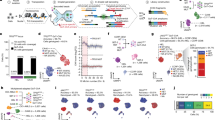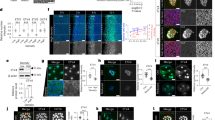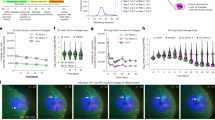Abstract
Haematopoietic stem cells (HSCs) are a self-renewing population of cells that continuously replenish all blood and immune cells during the lifetime of an individual1,2. HSCs are used clinically to treat a wide array of diseases, including acute leukaemias and congenital blood disorders, but obtaining suitable numbers of cells and finding immune-compatible donors remain serious problems. These difficulties have led to an interest in the conversion of embryonic stem cells or induced pluripotent stem cells into HSCs, which is not possible using current methodologies. To accomplish this goal, it is critical to understand the native mechanisms involved in the specification of HSCs during embryonic development. Here we demonstrate in zebrafish that Wnt16 controls a novel genetic regulatory network required for HSC specification. Non-canonical signalling by Wnt16 is required for somitic expression of the Notch ligands deltaC (dlc) and deltaD (dld), and these ligands are, in turn, required for the establishment of definitive haematopoiesis. Notch signalling downstream of Dlc and Dld is earlier than, and distinct from, known cell-autonomous requirements for Notch, strongly suggesting that novel Notch-dependent relay signal(s) induce the first HSCs in parallel to other established pathways. Our results demonstrate that somite-specific gene expression is required for the production of haemogenic endothelium.
This is a preview of subscription content, access via your institution
Access options
Subscribe to this journal
Receive 51 print issues and online access
$199.00 per year
only $3.90 per issue
Buy this article
- Purchase on Springer Link
- Instant access to full article PDF
Prices may be subject to local taxes which are calculated during checkout




Similar content being viewed by others
References
Gering, M. & Patient, R. Notch signalling and haematopoietic stem cell formation during embryogenesis. J. Cell. Physiol. 222, 11–16 (2010)
Staal, F. J. & Luis, T. C. Wnt signaling in hematopoiesis: crucial factors for self-renewal, proliferation, and cell fate decisions. J. Cell. Biochem. 109, 844–849 (2010)
Angers, S. & Moon, R. T. Proximal events in Wnt signal transduction. Nature Rev. Mol. Cell Biol. 10, 468–477 (2009)
Takada, S. et al. Wnt-3a regulates somite and tailbud formation in the mouse embryo. Genes Dev. 8, 174–189 (1994)
Goessling, W. et al. Genetic interaction of PGE2 and Wnt signaling regulates developmental specification of stem cells and regeneration. Cell 136, 1136–1147 (2009)
McWhirter, J. R. et al. Oncogenic homeodomain transcription factor E2A-Pbx1 activates a novel WNT gene in pre-B acute lymphoblastoid leukemia. Proc. Natl Acad. Sci. USA 96, 11464–11469 (1999)
Bertrand, J. Y. et al. Haematopoietic stem cells derive directly from aortic endothelium during development. Nature 464, 108–111 (2010)
Kissa, K. & Herbomel, P. Blood stem cells emerge from aortic endothelium by a novel type of cell transition. Nature 464, 112–115 (2010)
Boisset, J. C. et al. In vivo imaging of haematopoietic cells emerging from the mouse aortic endothelium. Nature 464, 116–120 (2010)
Bertrand, J. Y. et al. Definitive hematopoiesis initiates through a committed erythromyeloid precursor in the zebrafish embryo. Development 134, 4147–4156 (2007)
Kissa, K. et al. Live imaging of emerging hematopoietic stem cells and early thymus colonization. Blood 111, 1147–1156 (2008)
Lin, H. F. et al. Analysis of thrombocyte development in CD41-GFP transgenic zebrafish. Blood 106, 3803–3810 (2005)
Yokota, T. et al. Tracing the first waves of lymphopoiesis in mice. Development 133, 2041–2051 (2006)
Clements, W. K., Ong, K. G. & Traver, D. Zebrafish wnt3 is expressed in developing neural tissue. Dev. Dyn. 238, 1788–1795 (2009)
Nygren, M. K. et al. β-catenin is involved in N-cadherin-dependent adhesion, but not in canonical Wnt signaling in E2A–PBX1-positive B acute lymphoblastic leukemia cells. Exp. Hematol. 37, 225–233 (2009)
Teh, M. T. et al. Role for WNT16B in human epidermal keratinocyte proliferation and differentiation. J. Cell Sci. 120, 330–339 (2007)
Cirone, P. et al. A role for planar cell polarity signaling in angiogenesis. Angiogenesis 11, 347–360 (2008)
Julich, D. et al. beamter/deltaC and the role of Notch ligands in the zebrafish somite segmentation, hindbrain neurogenesis and hypochord differentiation. Dev. Biol. 286, 391–404 (2005)
Holley, S. A., Julich, D., Rauch, G. J., Geisler, R. & Nusslein-Volhard, C. her1 and the notch pathway function within the oscillator mechanism that regulates zebrafish somitogenesis. Development 129, 1175–1183 (2002)
Burns, C. E., Traver, D., Mayhall, E., Shepard, J. L. & Zon, L. I. Hematopoietic stem cell fate is established by the Notch-Runx pathway. Genes Dev. 19, 2331–2342 (2005)
Hadland, B. K. et al. A requirement for Notch1 distinguishes 2 phases of definitive hematopoiesis during development. Blood 104, 3097–3105 (2004)
Kumano, K. et al. Notch1 but not Notch2 is essential for generating hematopoietic stem cells from endothelial cells. Immunity 18, 699–711 (2003)
Robert-Moreno, A., Espinosa, L., de la Pompa, J. L. & Bigas, A. RBPjκ-dependent Notch function regulates Gata2 and is essential for the formation of intra-embryonic hematopoietic cells. Development 132, 1117–1126 (2005)
Robert-Moreno, A. et al. Impaired embryonic haematopoiesis yet normal arterial development in the absence of the Notch ligand Jagged1. EMBO J. 27, 1886–1895 (2008)
Scheer, N. & Campos-Ortega, J. A. Use of the Gal4-UAS technique for targeted gene expression in the zebrafish. Mech. Dev. 80, 153–158 (1999)
Scheer, N., Groth, A., Hans, S. & Campos-Ortega, J. A. An instructive function for Notch in promoting gliogenesis in the zebrafish retina. Development 128, 1099–1107 (2001)
Ren, X., Gomez, G. A., Zhang, B. & Lin, S. Scl isoforms act downstream of etsrp to specify angioblasts and definitive hematopoietic stem cells. Blood 115, 5338–5346 (2010)
Kemp, C., Willems, E., Abdo, S., Lambiv, L. & Leyns, L. Expression of all Wnt genes and their secreted antagonists during mouse blastocyst and postimplantation development. Dev. Dyn. 233, 1064–1075 (2005)
Corrigan, P. M., Dobbin, E., Freeburn, R. W. & Wheadon, H. Patterns of Wnt/Fzd/LRP gene expression during embryonic hematopoiesis. Stem Cells Dev. 18, 759–772 (2009)
Westerfield, M. The Zebrafish Book. A Guide for the Laboratory Use of Zebrafish (Danio Rerio) (Univ. Oregon Press, 2004)
Parsons, M. J. et al. Notch-responsive cells initiate the secondary transition in larval zebrafish pancreas. Mech. Dev. 126, 898–912 (2009)
Turner, D. L. & Weintraub, H. Expression of achaete-scute homolog 3 in Xenopus embryos converts ectodermal cells to a neural fate. Genes Dev. 8, 1434–1447 (1994)
Clements, W. K. & Kimelman, D. LZIC regulates neuronal survival during zebrafish development. Dev. Biol. 283, 322–334 (2005)
Lele, Z., Bakkers, J. & Hammerschmidt, M. Morpholino phenocopies of the swirl, snailhouse, somitabun, minifin, silberblick, and pipetail mutations. Genesis 30, 190–194 (2001)
Nüsslein-Volhard, C. & Dahm, R. Zebrafish (Oxford Univ. Press, 2002)
Bertrand, J. Y., Kim, A. D., Teng, S. & Traver, D. CD41+ cmyb+ precursors colonize the zebrafish pronephros by a novel migration route to initiate adult hematopoiesis. Development 135, 1853–1862 (2008)
Acknowledgements
The authors wish to thank L. Zon, K. Poss, D. Kimelman, M. Lardelli, B. Appel, C. Burns, J. Campos-Ortega, D. Ransom, N. Trede, J. Lewis, M. Pack, S. Holley, C. Moens, B. Paw, R. Karlström and J. Waxman for probe constructs. L. Zon, R. Dorsky, S. Lin and S. Holley provided transgenic and mutant zebrafish lines. C. Weaver, K. Willert, K. J. P. Griffin, J. Bertrand, D. Stachura and Y. Lee provided critical evaluation of the manuscript. This research was funded by an AHA Postdoctoral Fellowship 0725086Y to W.K.C., an AHA Predoctoral Founders Affiliate Fellowship 0815732D to J.C.M., NIH R01-HL093467 to N.L. and NIH R01-DK074482, CIRM New Investigator Award, and March of Dimes 6-FY09-508 to D.T.
Author information
Authors and Affiliations
Contributions
W.K.C. and D.T. designed all experiments. Whole-mount immunofluorescence, double fluorescence in situs, and Kaede-based fate mapping was performed by A.D.K. K.G.O. cloned and subcloned multiple constructs. J.C.M and N.L. generated Notch reporter lines. All other experiments were performed by W.K.C. The manuscript was written by W.K.C. and edited by N.L. and D.T., with critical input as described in the Acknowledgments.
Corresponding author
Ethics declarations
Competing interests
The authors declare no competing financial interests.
Supplementary information
Supplementary Information
The file contains Supplementary Figures 1-15 with legends and Supplementary Tables 1-9. (PDF 3823 kb)
Supplementary Movie 1
The movie shows timelapse imaging of GFP+ HSCs in the trunk region of untreated cd41:GFP transgenic animals captured at 1 frame per 3 minutes from 50 hpf to 75 hpf, documenting the behaviour of HSCs in this time period. (MOV 8601 kb)
Supplementary Movie 2
The movie shows timelapse imaging of lack of GFP+ HSCs in the trunk region of W16MO-injected cd41:GFP transgenic animals captured at 1 frame per 3 minutes from 50 hpf to 75 hpf, documenting decreased HSCs in this time period. (MOV 6967 kb)
Supplementary Movie 3
The movie shows timelapse imaging of GFP+ thymic immigrants in the head region of untreated cd41:GFP transgenic animals captured at 1 frame per 3 minutes from 50 hpf to 75 hpf, documenting the transition of HSCs to nascent T cells in this time period. (MOV 9791 kb)
Supplementary Movie 4
The movie shows timelapse imaging of lack of GFP+ thymic immigrants in the head region of W16MO-injected cd41:GFP transgenic animals captured at 1 frame per 3 minutes from 50 hpf to 75 hpf, documenting decreased transition of HSCs to nascent T cells in this time period. (MOV 6550 kb)
Rights and permissions
About this article
Cite this article
Clements, W., Kim, A., Ong, K. et al. A somitic Wnt16/Notch pathway specifies haematopoietic stem cells. Nature 474, 220–224 (2011). https://doi.org/10.1038/nature10107
Received:
Accepted:
Published:
Issue Date:
DOI: https://doi.org/10.1038/nature10107
This article is cited by
-
Nlrc3 signaling is indispensable for hematopoietic stem cell emergence via Notch signaling in vertebrates
Nature Communications (2024)
-
Multiple Mechanisms Explain Genetic Effects at the CPED1-WNT16 Bone Mineral Density Locus
Current Osteoporosis Reports (2023)
-
CellComm infers cellular crosstalk that drives haematopoietic stem and progenitor cell development
Nature Cell Biology (2022)
-
Mesoderm-derived PDGFRA+ cells regulate the emergence of hematopoietic stem cells in the dorsal aorta
Nature Cell Biology (2022)
-
The pancancer landscape of Wnt family expression reveals potential biomarkers in urinary system tumors
Cancer Gene Therapy (2021)
Comments
By submitting a comment you agree to abide by our Terms and Community Guidelines. If you find something abusive or that does not comply with our terms or guidelines please flag it as inappropriate.



